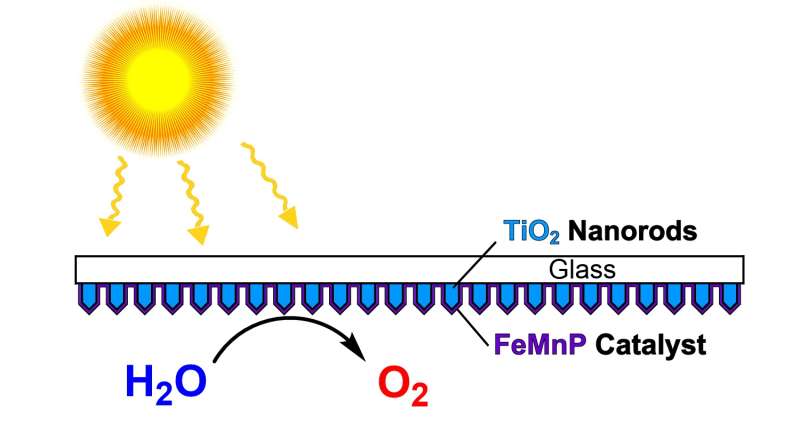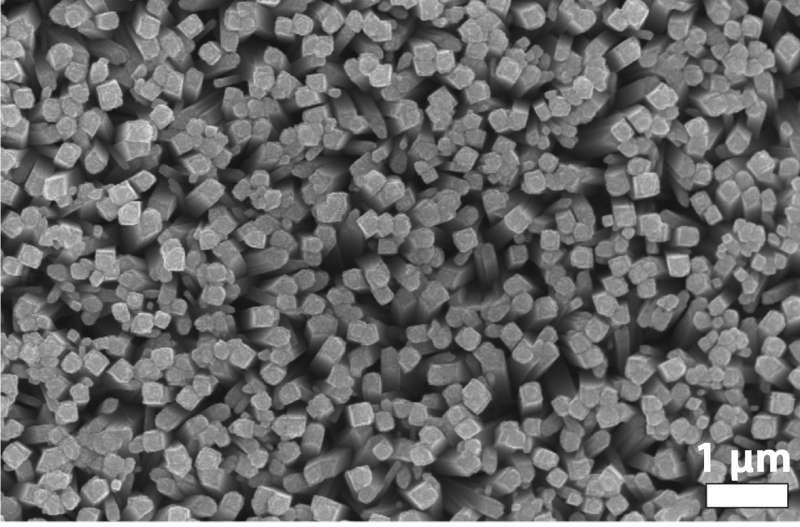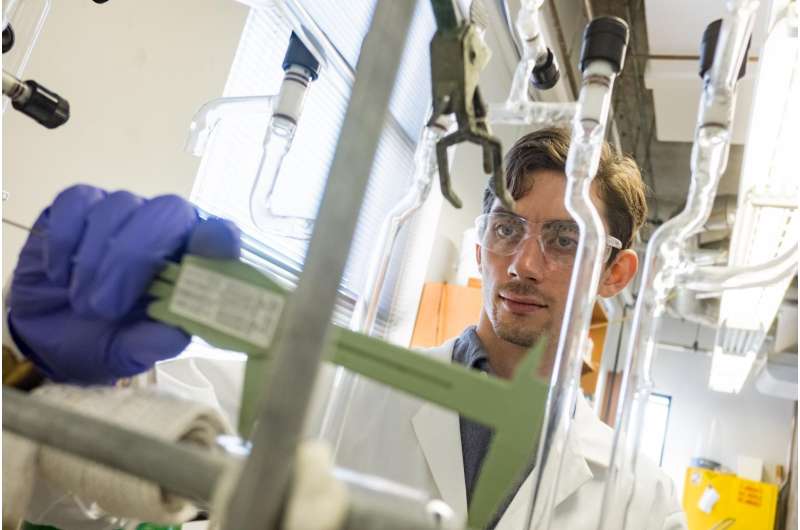Artificial photosynthesis steps into the light

Rice University scientists have created an efficient, simple-to-manufacture oxygen-evolution catalyst that pairs well with semiconductors for solar water splitting, the conversion of solar energy to chemical energy in the form of hydrogen and oxygen.
The lab of Kenton Whitmire, a Rice professor of chemistry, teamed up with researchers at the University of Houston and discovered that growing a layer of an active catalyst directly on the surface of a light-absorbing nanorod array produced an artificial photosynthesis material that could split water at the full theoretical potential of the light-absorbing semiconductor with sunlight.
An oxygen-evolution catalyst splits water into hydrogen and oxygen. Finding a clean renewable source of hydrogen fuel is the focus of extensive research, but the technology has not yet been commercialized.
The Rice team came up with a way to combine three of the most abundant metals—iron, manganese and phosphorus—into a precursor that can be deposited directly onto any substrate without damaging it.
To demonstrate the material, the lab placed the precursor into its custom chemical vapor deposition (CVD) furnace and used it to coat an array of light-absorbing, semiconducting titanium dioxide nanorods. The combined material, called a photoanode, showed excellent stability while reaching a current density of 10 milliamps per square centimeter, the researchers reported.

The results appear in two new studies. The first, on the creation of the films, appears in Chemistry: A European Journal. The second, which details the creation of photoanodes, appears in ACS Nano.
Whitmire said the catalyst is grown from a molecular precursor designed to produce it upon decomposition, and the process is scalable. The Rice lab combined iron, manganese and phosphorus (FeMnP) into a molecule that converts to a gas when vacuum is applied. When this gas encounters a hot surface via CVD, it decomposes to coat a surface with the FeMnP catalyst.
The researchers claim their film is "the first heterobimetallic phosphide thin film" created from iron, manganese and phosphorus that starts out as a single precursor. The resulting films contain stable hexagonal arrays of atoms that, until now, had only been seen at temperatures above 1,200 degrees Celsius. The Rice films were created at 350 degrees C in 30 minutes.
"Temperatures above 1,200 C destroy the semiconductor array," Whitmire said. "But these films can be made at low temperatures, allowing them to evenly coat and interact with the photo absorber and create a hybrid electrode."
The researchers coated the three-dimensional arrays of titanium dioxide nanorods with the metallic-looking film. The composite material showed potential as a high-surface-area semiconductor for photoelectrochemical cells.

Growing the transition metal coating directly onto the nanorods allows for maximum contact between the two, Whitmire said. "That metallic, conductive interface between the semiconductor and the active catalytic surface is key to the way this device works," he said.
The film also has ferromagnetic properties, in which the atoms' magnetic moments align in the same direction. The film has a low Curie temperature, the temperature at which some materials' magnetic properties need to be induced. That could be useful for magnetic refrigeration, the researchers said.
Having established their technique, Whitmire said it will now be much easier to investigate hybrid catalysts for many applications, including petrochemical production, energy conversion and refrigeration.
"It seems like when it rains, it pours," he said. "We spent a very long time putting everything together, and now all of a sudden there are too many things to do."
More information: Read the Chemistry abstract at onlinelibrary.wiley.com/doi/10 … /chem.201700203/full
Read the ACS Nano abstract at pubs.acs.org/doi/abs/10.1021/acsnano.7b00704
Journal information: Chemistry – A European Journal , ACS Nano
Provided by Rice University




















